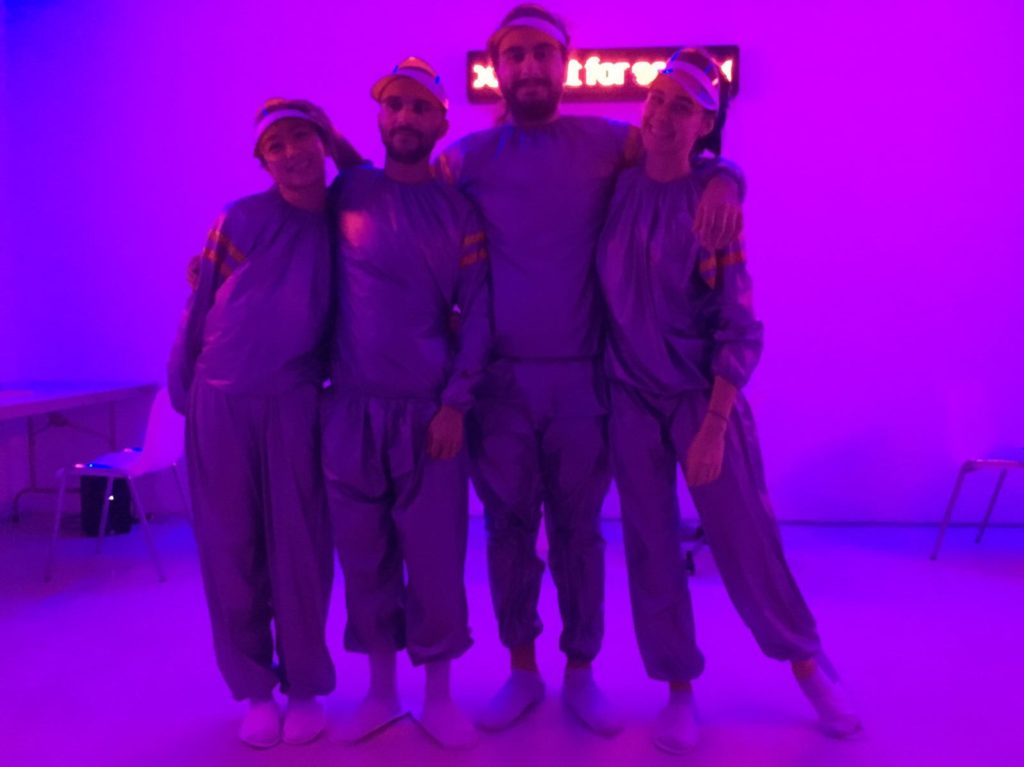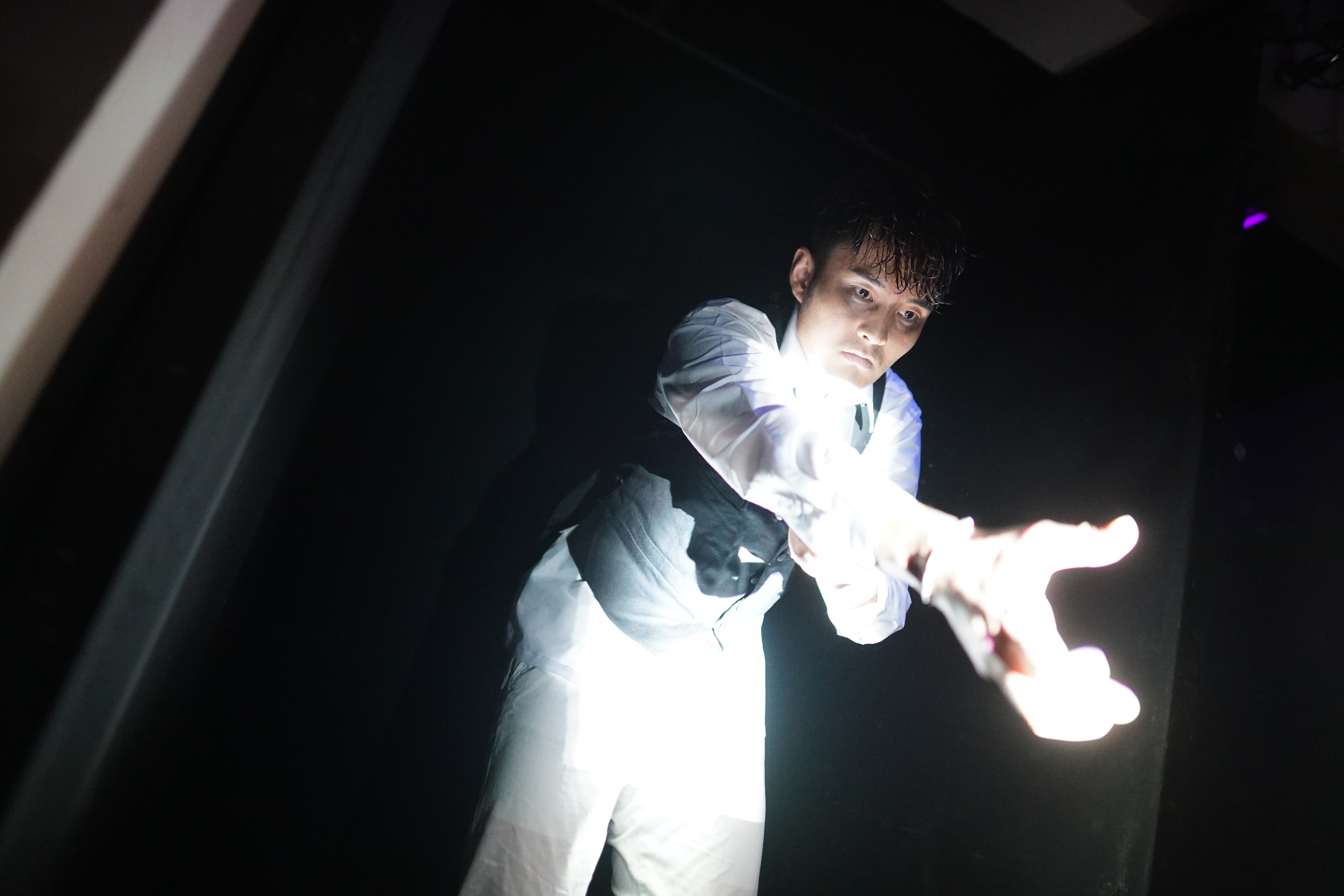Abstract
The mixed media installation called ‘Leisure Time Center, 2037’ raises questions on the future of work and the role that humans are going to play in an automated society. What will happen to us, if everybody has more time at free disposal? After entering the hypothetical center of the future, people had to undergo a questionnaire, which would diagnose them with a problem that was based on our research and for which they then had to get a treatment we designed.
Outside
The installation took place on the 25th of November 2017 in a former squash-hall on the Kai Tak campus of the Academy of Visual Arts in Hong Kong. A computer voice greeted and addressed the visitors by giving a short introduction on the context of the center.
‘Hello and welcome to the Leisure Time Center on this nice Saturday evening of the 25th November 2037. Life without work is time. We value your time a lot. We will diagnose your needs and improve your life together. Soon it’s your turn to enter. Please be patient. We hope you enjoy your time. Time is important.’
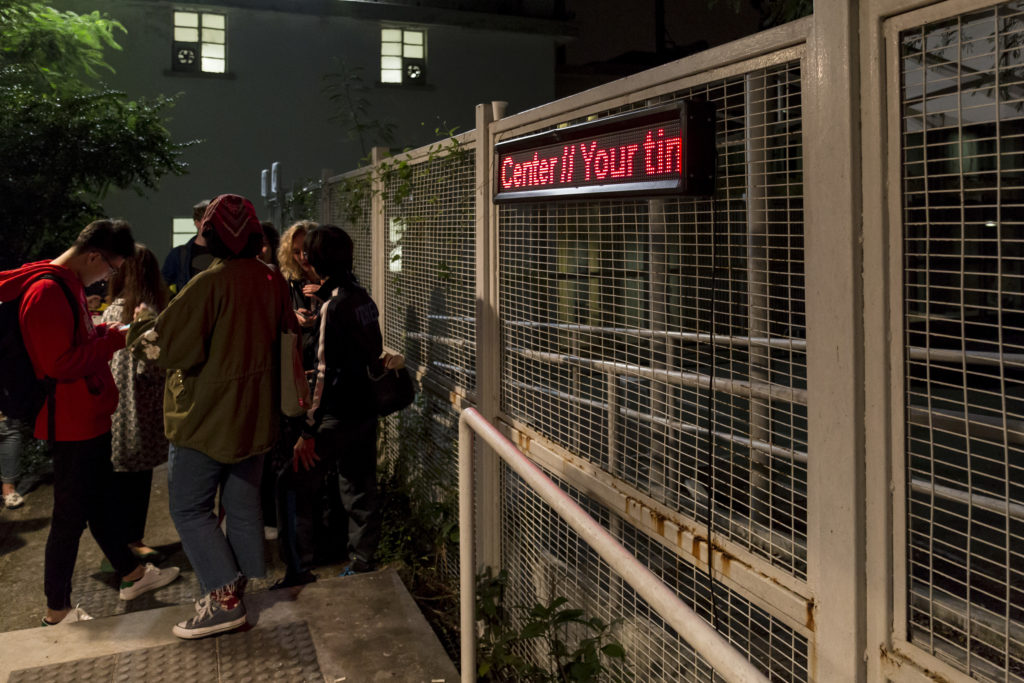
A LED sign displayed the name ‘Leisure Time Center’ as well as the slogan ‘Your time is important’ and set the visual mood for the interior design in the space.
After waiting in line people were separately let into the center by a performer.
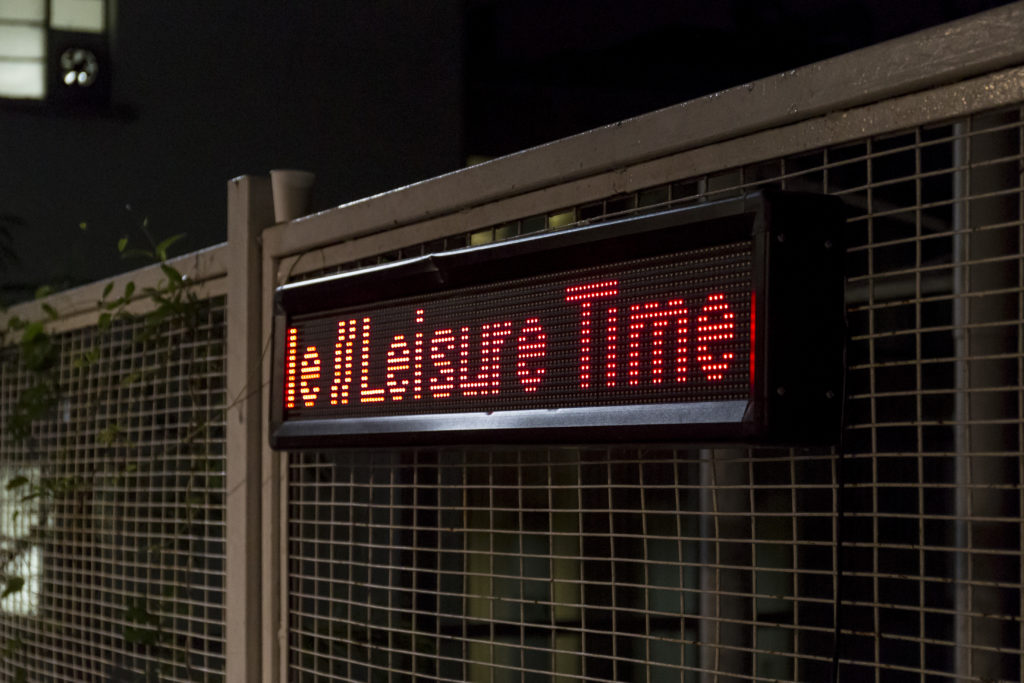
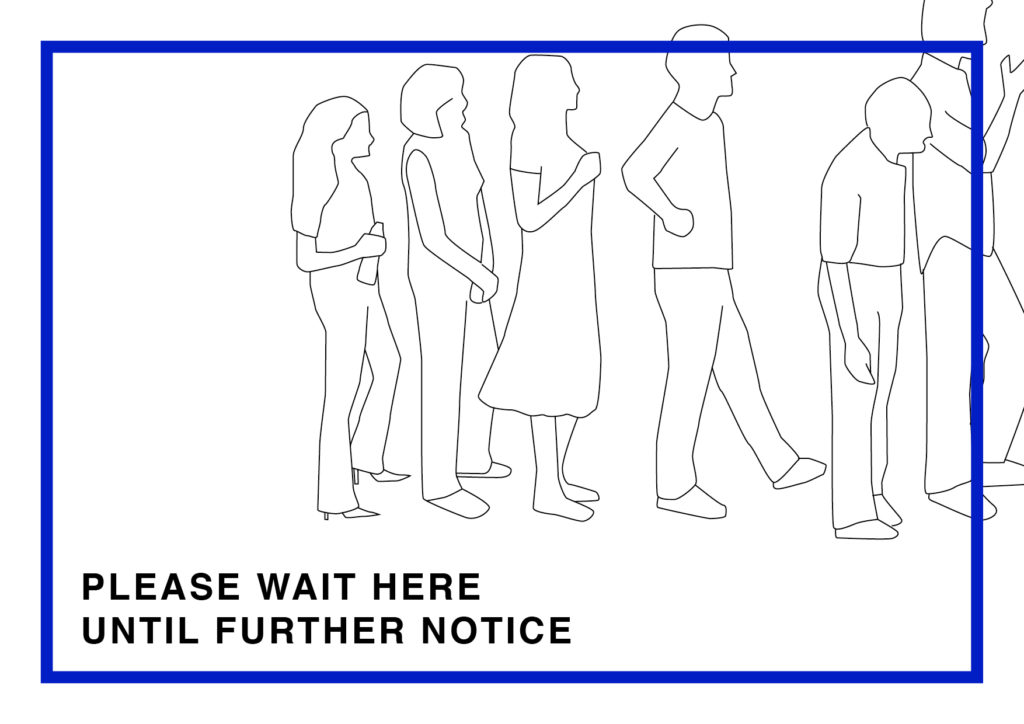
Performers
Behavior
In order to create this illusion of a futuristic environment, the behaviour of our performers was crucial: They should behave in an uncanny way and keep a certain distance to the patients. No smiling, no interactions other than those written below. For reference we sent this link of Luna Lovegood, a fictional character from the Harry Potter movies, who has this sense of eeriness we would like to achieve.
Costumes
The costumes should fit in with the futuristic setting we had in mind. For this, we agreed on these sweatsuits we found on a chinese e-commerce platform. They were simplistic yet very uncommon, which matched well together with the ambiance we created in the exhibition room. The room, together with our outfits evoked a clean, sterile and oddly professional environment, thus enhancing the atmosphere of a place somewhat in the future.
Biased
When researching we stumbled upon a few articles discussing racial and gender problem that are evoked again by the rise of AI. They argued that since mostly white men are working on this probably very path-breaking technology needs of marginalised groups can get overlooked. Therefore we chose the roles for the performers based on stereotypes. For less talkative, serving roles we chose women and for the active roles we chose men.
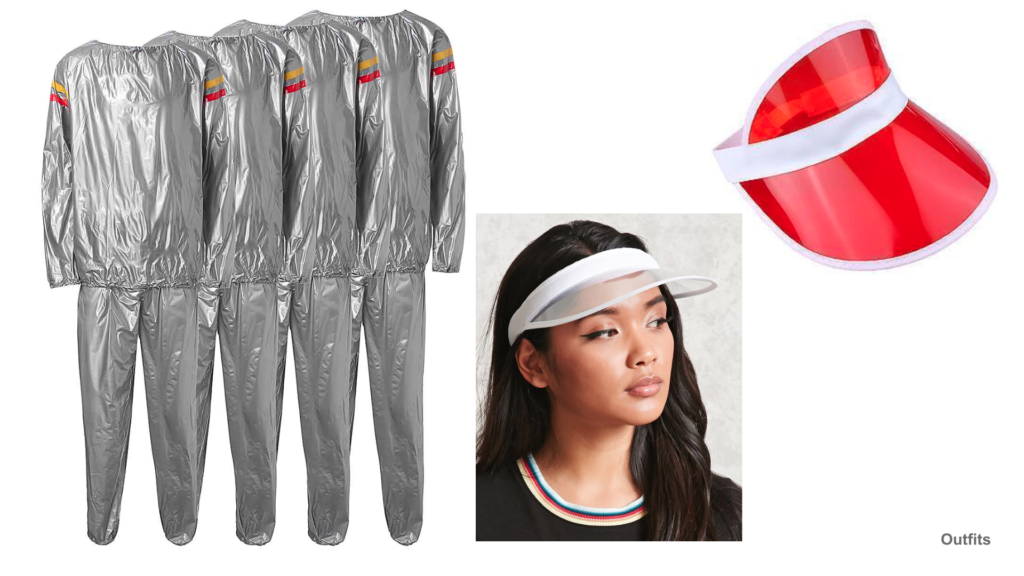
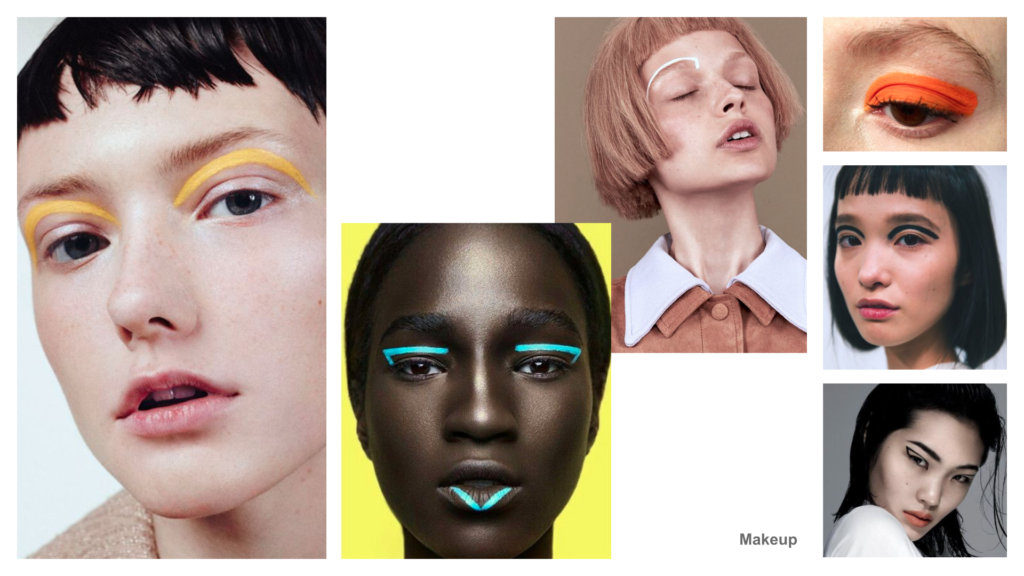
Questionnaire
Once people entered the center they were greeted by a hologram of a futuristic woman:
‘Hello and Welcome. I will ask you a certain set of questions about your life, your time and your feelings. Afterwards my algorithm will determine the fitting procedure for your situation.’
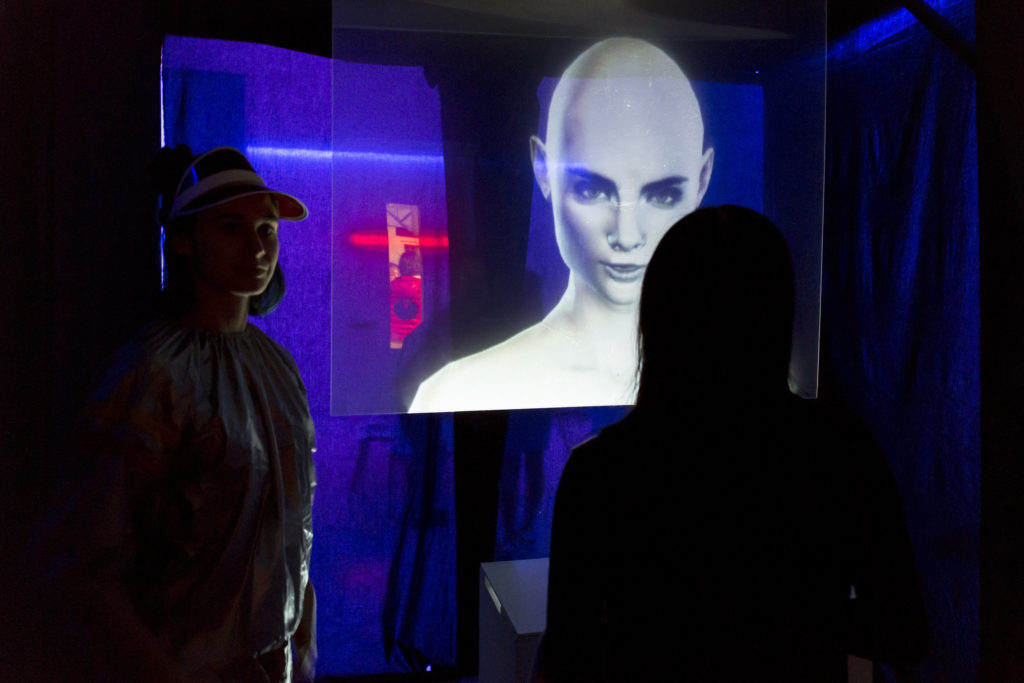
We used an acrylic plate on which we applied a special foil. That allowed us to project an image onto the see-through plate from the back and create the illusion of the image floating in the air. In front of the plate we placed a pillar where a infrared sensor was recessed. It was connected to an Arduino which read out the data and sent it to a MacBook where Processing was running. We used Processing to handle the video files and make use of the sensor-data. The sensor measured the distance between the pillar and the ceiling, so when someone placed their hand over the pillar, the measured distance would not match the pillar-ceiling distance anymore. Processing would then overlay the measured distance in real time over the video, next to the talking head.
After the introduction the projection explained the further proceeding:
‘Please put your hand above the sensor now. You can indicate with your hand position how much the following question relates to your situation. The higher your hand is, the more you agree.’
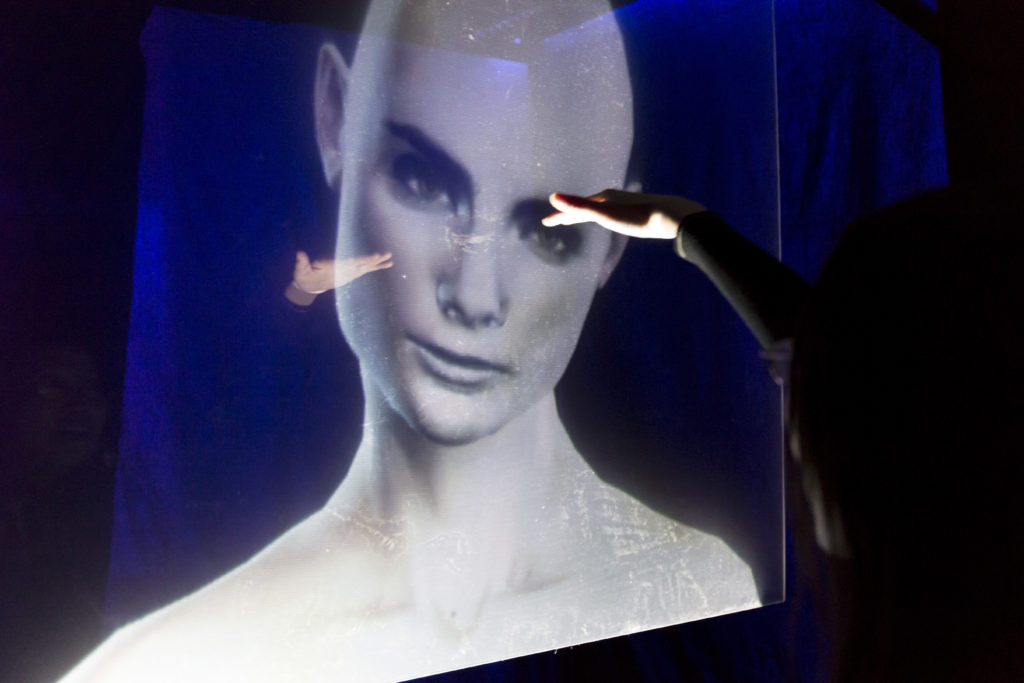
It was important to us to have an input method matching the overall futuristic look of the center. For this we looked at interfaces in science fiction movies and the predicted next revolution of user interfaces. The first interfaces were using command lines, where you’d have to type out every command. Users had to learn and recall these commands. The next step were graphical user interfaces, that is what we also mostly use today. Icons on the screen and a mouse pointer give a graphical abstraction of what is happening inside the computer. Exploration and recognition are the keywords used for this kind of interface. The next step were natural interfaces where touchscreens allow gestures directly on the graphical layer. The interaction should be based on intuition and natural behaviour. Predictions say we will move further away from screens and have tangible interfaces where commands have physical manifestations in the real world or even radical atoms were all digital information has a form that can be interacted with directly. We did some tests with different sensors and objects that served as this physical manifestation of the interaction. Because we liked the clean and somewhat uncanny aspect of the distance sensor we settled for this. User tests showed, that people still needed some kind of feedback, that’s why we integrated the display of the distance as soon as people interacted with the interface.
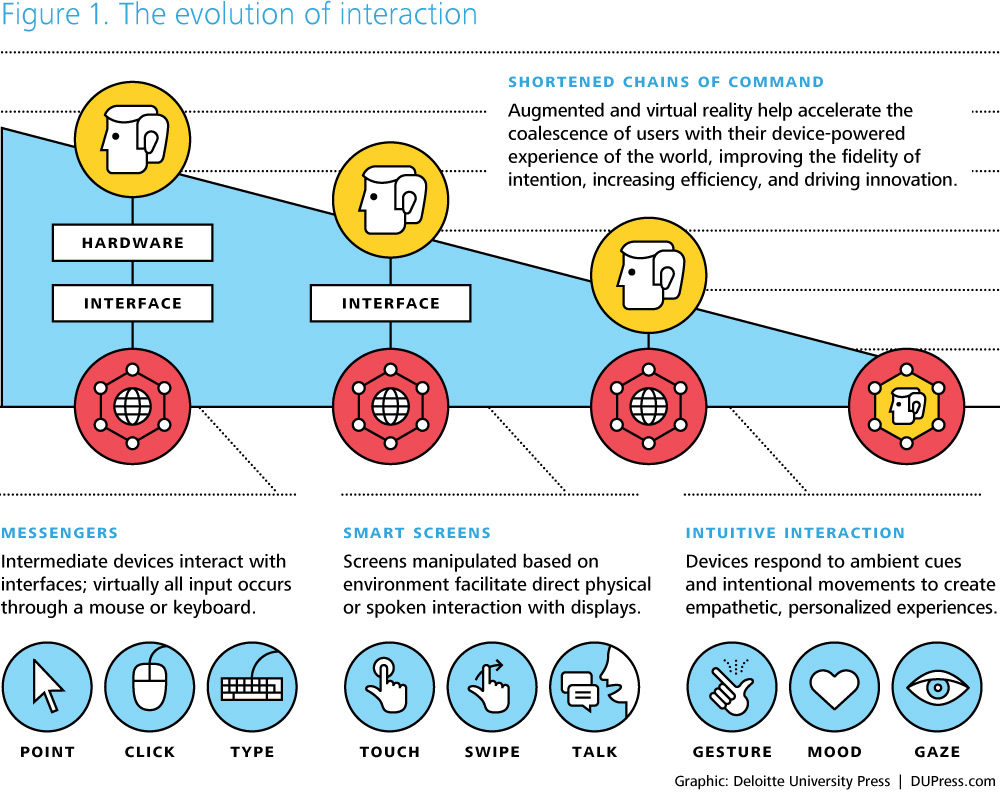
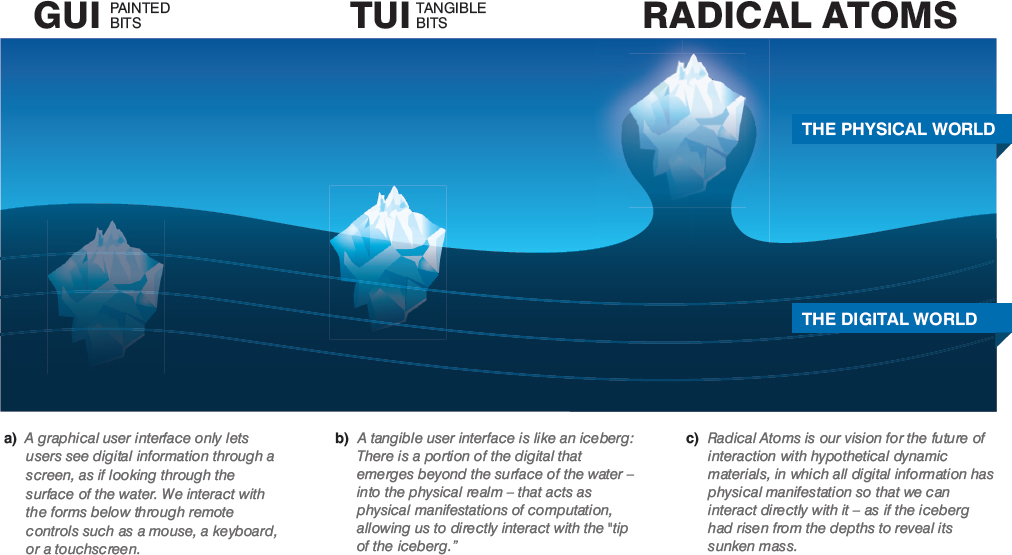
These were the questions asked:
Thinking about your life in 2017 and comparing it to today with having all this free time. Do you miss working?
Without having the pressure of basic needs do you have an absence of emotional sensation?
Without the structure of daily work, do you feel a lack of energy in your life?
Do you think your life has lost significance without work?
Due to all your leisure time, do you feel a lack of productive ways to fill your day?
Do you wish to be more robotic?
Thank you. The examination is over.
After having answered all the questions the encrypted diagnoses was given to the visitor.
The program chose it based on the saved sensor data. The performer would then lead the visitor out of the separate diagnoses room into the hall.
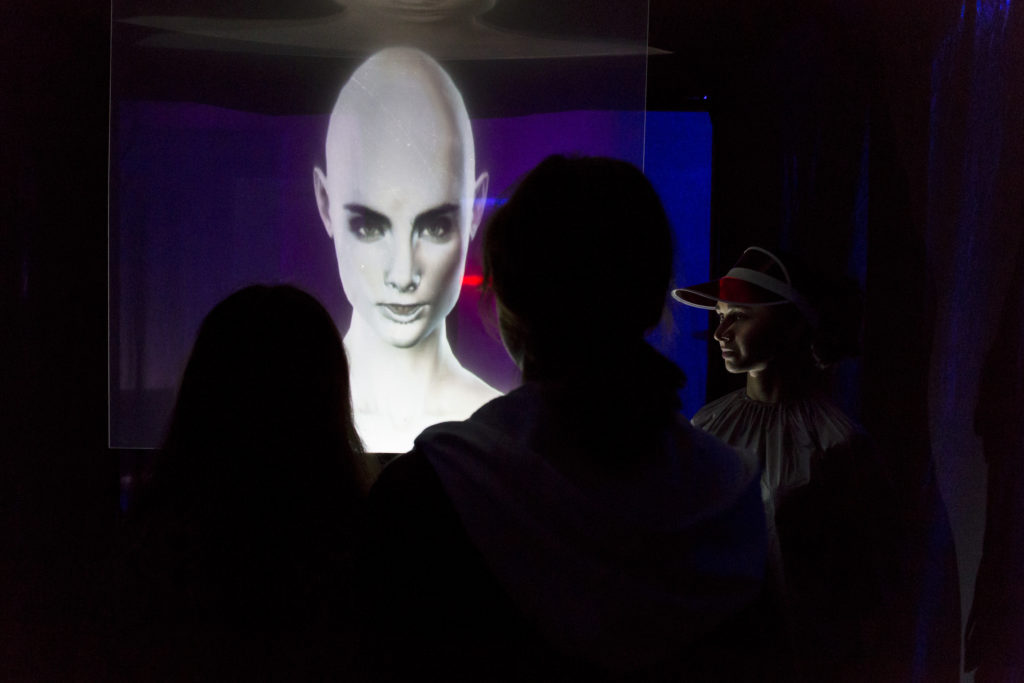
Interior
Once people entered the center another performer would guide them to the waiting area in the middle of the room. We decided to seat the people on chairs facing the different stations which implied the impression of a waiting room before leading them to the treatment station. On one hand this would prevent clashes at the stations, on the other hand it would give visitors some time to get into the atmosphere of the room and examine the setup.
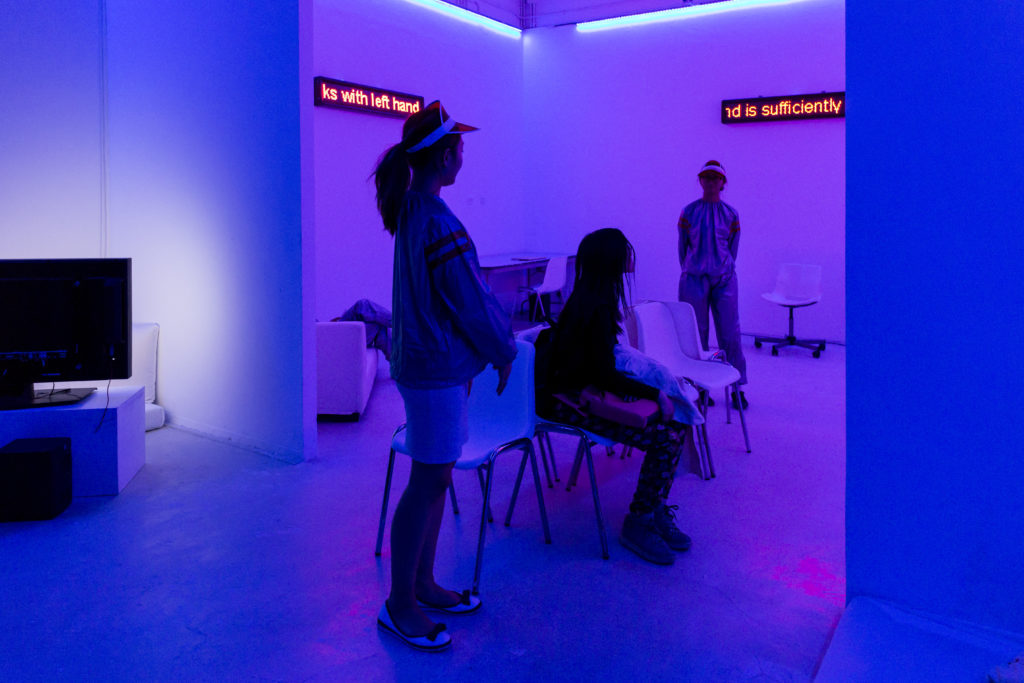
We installed downward facing LED stripes on every wall at about 3 meters height . An animation of blue waves running around the room would light up the walls and create a soothing, hypnotic atmosphere. We increased the oceanic aesthetic with looping whale and wave sounds.
We had three LED signs installed on each wall. On every sign there was one quote we stumbled upon during our research. While being seated in the waiting area, the audience had a chance to read them and thus get an abstract of what our work was trying to debate. All the quotes were orbiting around the role societies and humankind in general would obtain once we were liberated from labour. Ultimately, we wanted to evoke the question of what would happen with our identity and purpose in life in a world without were we would not have to work.
Seldom has any society offered so wide a range of acceptable and readily available leisure time activities.
– Alvin Töffler
He is happy who lives in accordance with complete virtue and is sufficiently equipped with external goods, not for some chance period but throughout a complete life.
– Aristotle
This is the advent of automation, which in a few decades probably will empty the factories and liberate mankind from its oldest and most natural burden, the burden of laboring and the bondage to necessity.
– Hannah Arendt
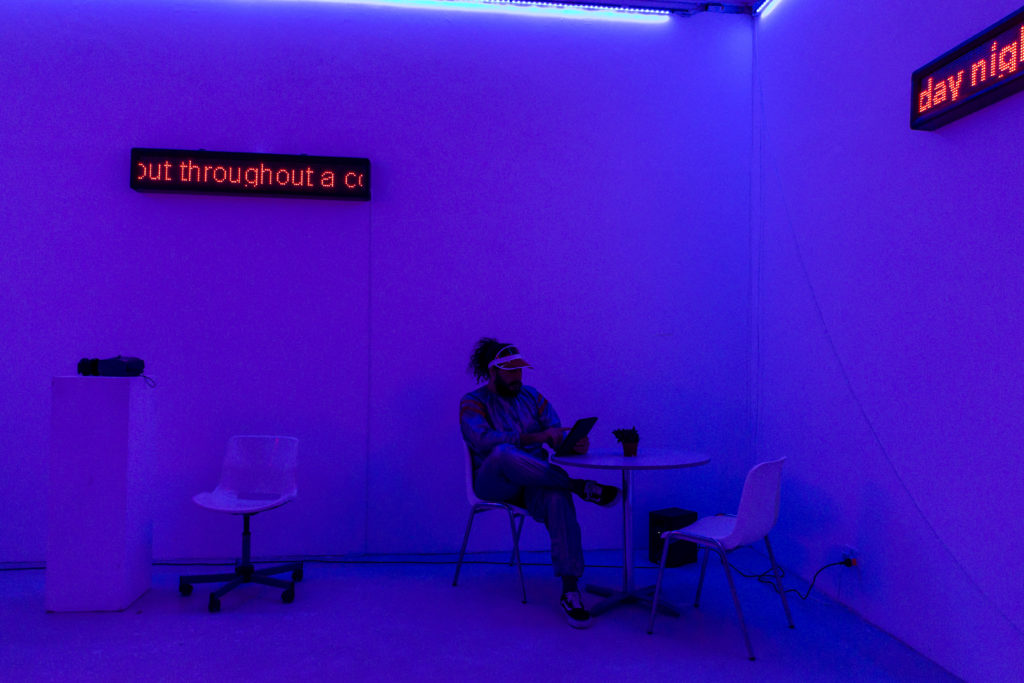
After about five minutes a performer would get the visitor and guide them to the according treatment station.
Stations
Each station was based on a hypothesis from futurists or philosophers about how a life without work could look like.
Numbness
You have been diagnosed with the feeling of numbness, caused through the lack of pressure to provide for yourself. To stimulate the emotions of liveliness and adrenalin, your treatment will be the knife procedure. Please place your hand on the underlay and begin.
Our therapist will advise you when your session is over. Until then, please remain seated.
Concept:
The idea behind this station was to evoke thrill and emotions and a sense of vulnerability. Our thesis was that in a world were the basic existential needs for every human would be provided by governments and corporations, humankind would lose the sense of pressure of needing to earn money and secure themselves an income in order to survive and thus, feel a sensation of numbness.
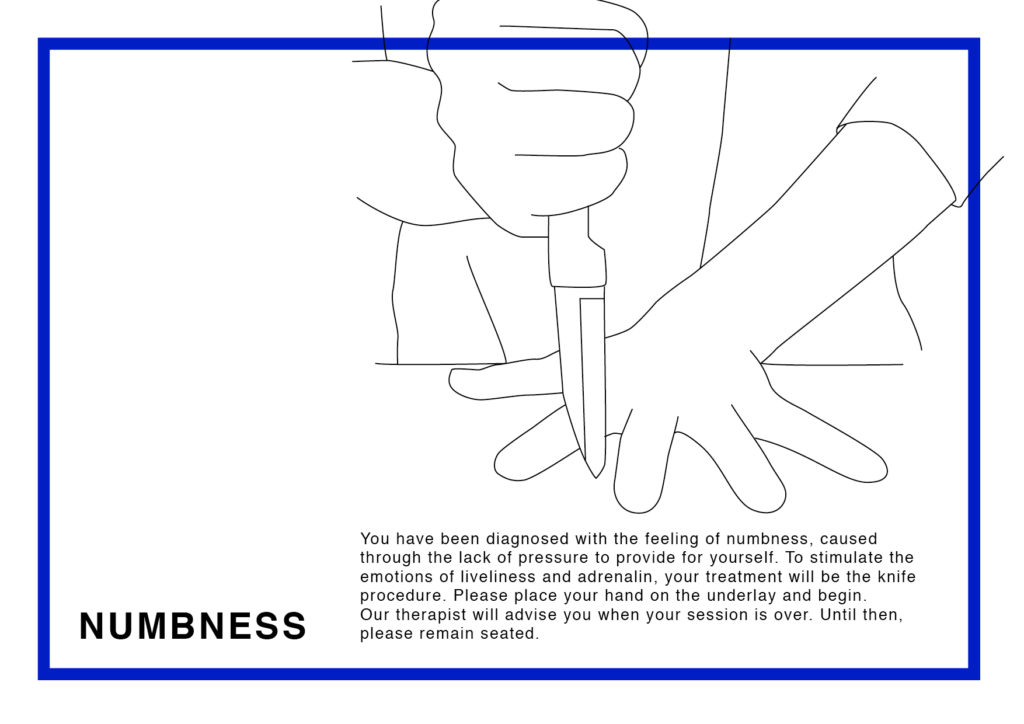
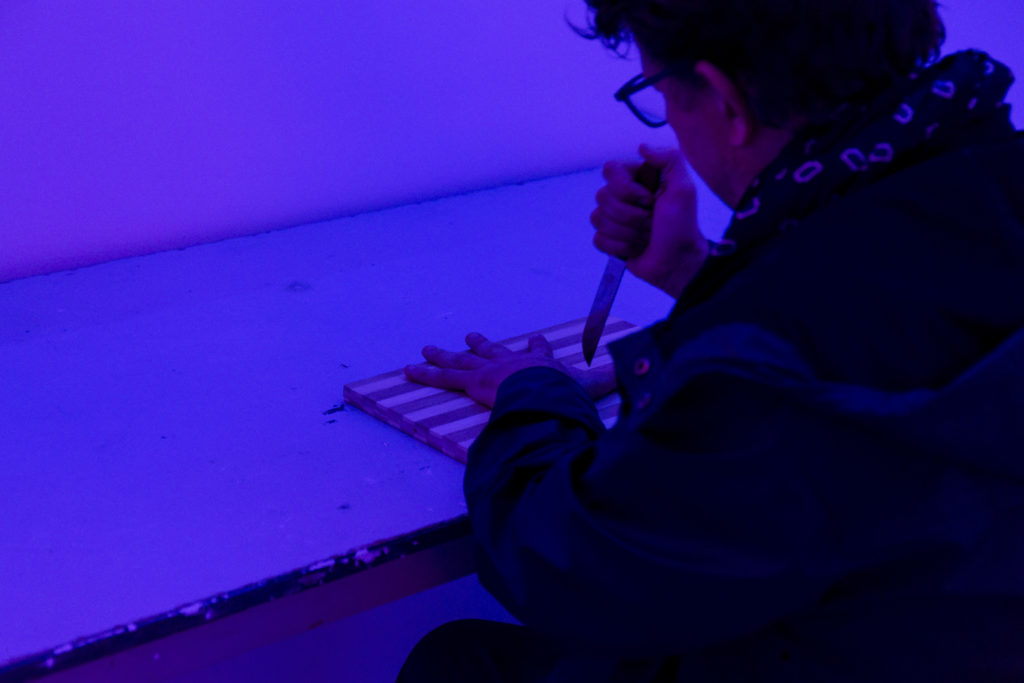
Nostalgia
You are suffering from a sentimental yearning for the happiness of a former place or time – in this case, the work environment. To alleviate your distress, you may choose between an experience in the manufacture industry (design or food) and the office environment. Please advise your therapist the workplace you would like to immerse in. Once your session is over, please raise your hand and remain seated.
Concept:
This station was designed for a generation which would have experienced the economy both before and after the third industrial revolution. With a VR-Headset, they would be able to immerse back in an environment which reminded them somewhat of their old workplace. Here they could reminisce and maybe get a resembling sensation of what they felt while they were working.
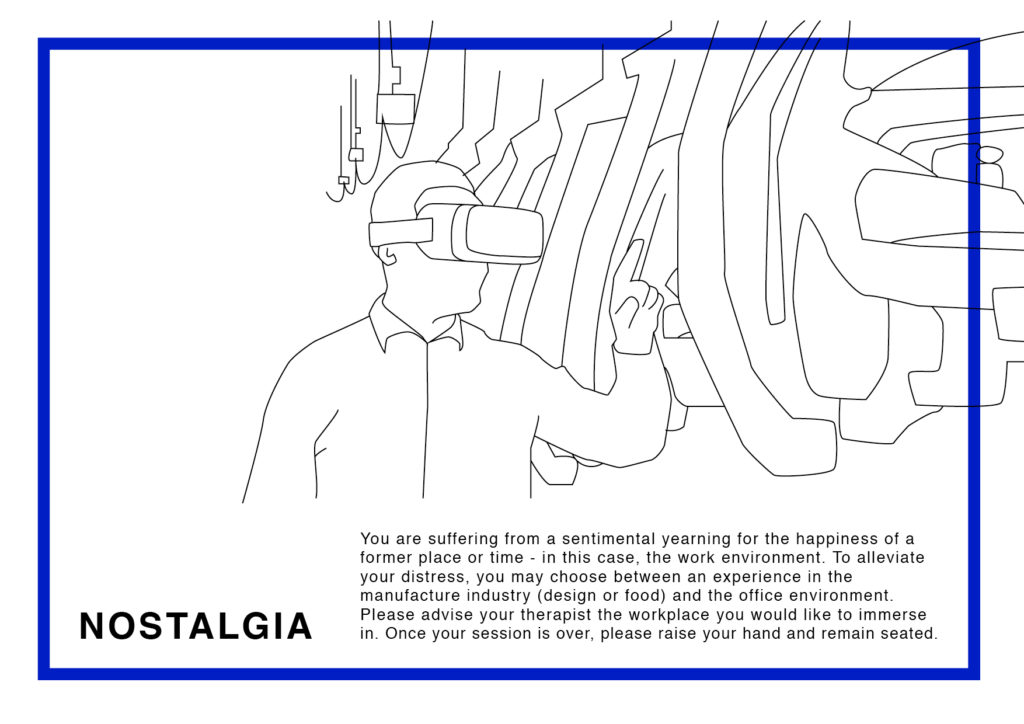
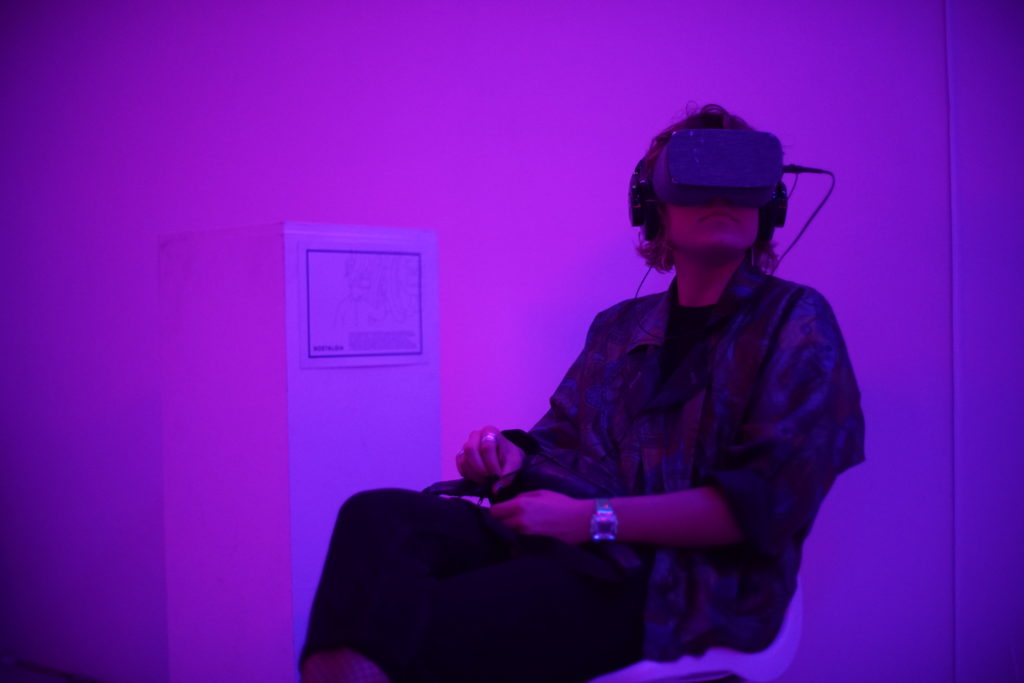
Isolation
The sensation of solitude and seclusion is evoked through the loss of daily conversations and social encounters, often those once enjoyed during the workplace. You will have a bilateral session with our therapist. Please lay down. Your therapist will advise you once your treatment is over.
Concept:
In our opinion, solitude and seclusion was an obvious symptom of a automated world. Our treatment was simple, yet highly intimate: the patient would lie on a mattress, together with a therapist and just keep eye contact with her for around five minutes, while facing each other within a distance of roughly 20 cm. Our therapist was adamant about keeping a serious, gesture and facial expression, thus evoking a oddly uncomfortable, yet intimate ambiance. Our therapist would greet the patient with a brief introduction to the station: “You have been diagnosed with isolation caused by the lack of social encounters you experienced at your workplace, amongst other things. Please lay down, relax and try to keep steady eye contact with me until I indicate the session is over. There will be no body contact or exchange of words.”
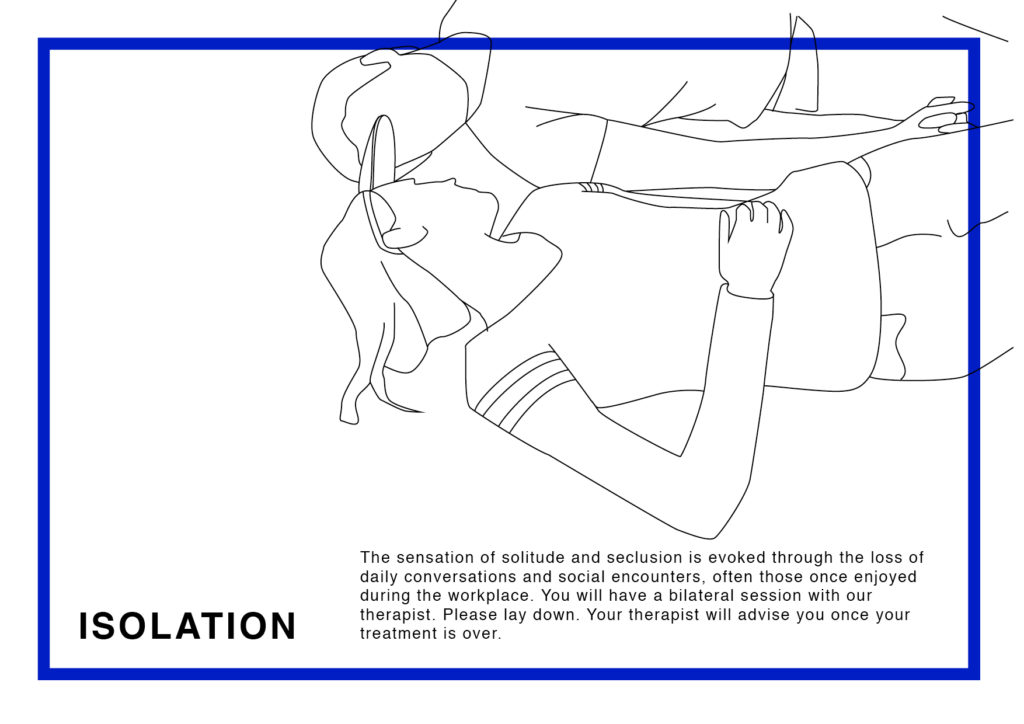
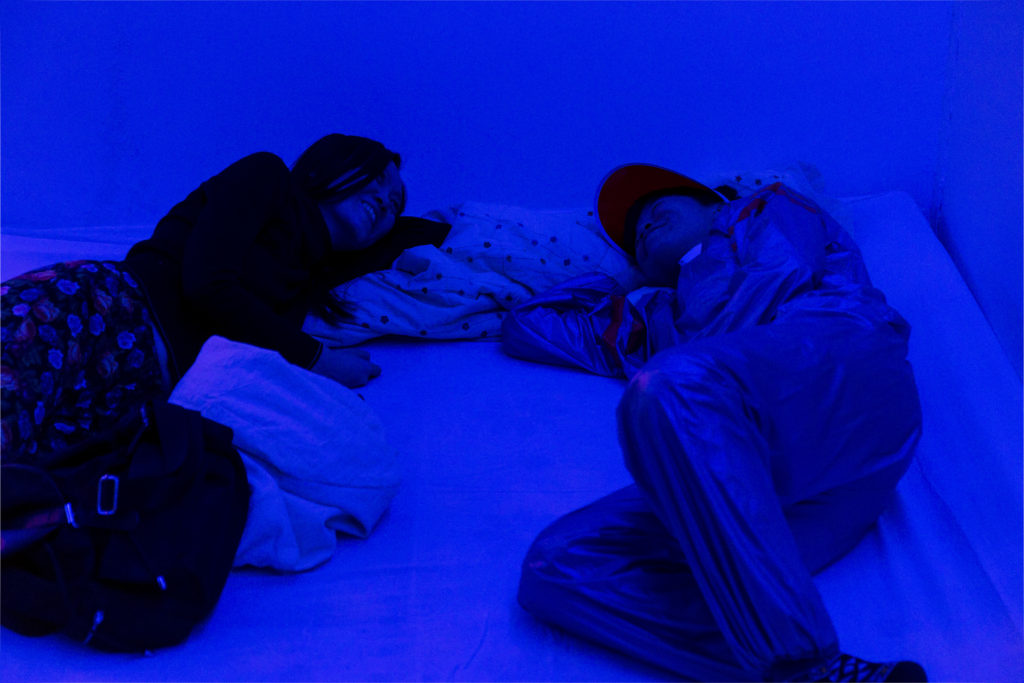
Envy
Envy occurs when one lacks another person’s superior qualities. Regarding the working environment, these superiors are robots and Artificial Intelligence. This audiovisual treatment will relieve your envy by demonstrating what makes humankind inherently different than robots and thus our lives profoundly more enjoyable. Once your session is over, please raise your hand and remain seated.
Concept:
This station was guided by the basic question of what makes humans human and therefore essentially distinguishable from robots. The conclusion was our freedom to enjoy ourselves and each other by procreating or simply enjoying the act of sexual encounters. Therefore we seated the patients in front of a flatscreen and showed him or her footage of facial expressions from humans during masturbation. The clips were eacht around 3 minutes long and had the intent to show the audience what made living as a creature more enjoyable than the seeming invincibility of robots and artificial intelligence.
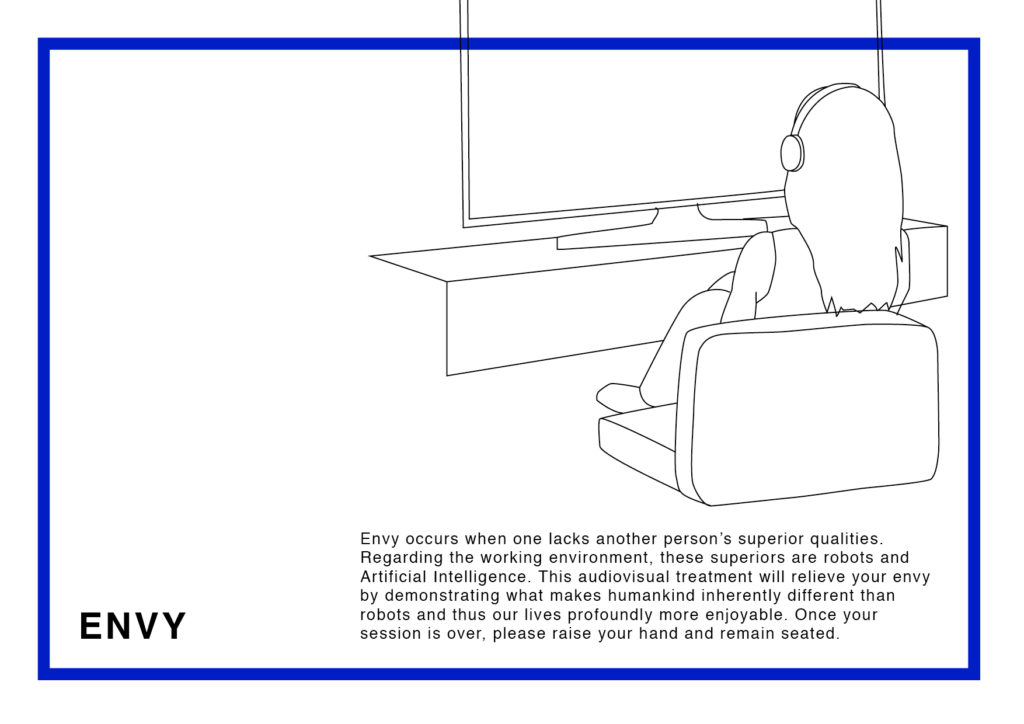
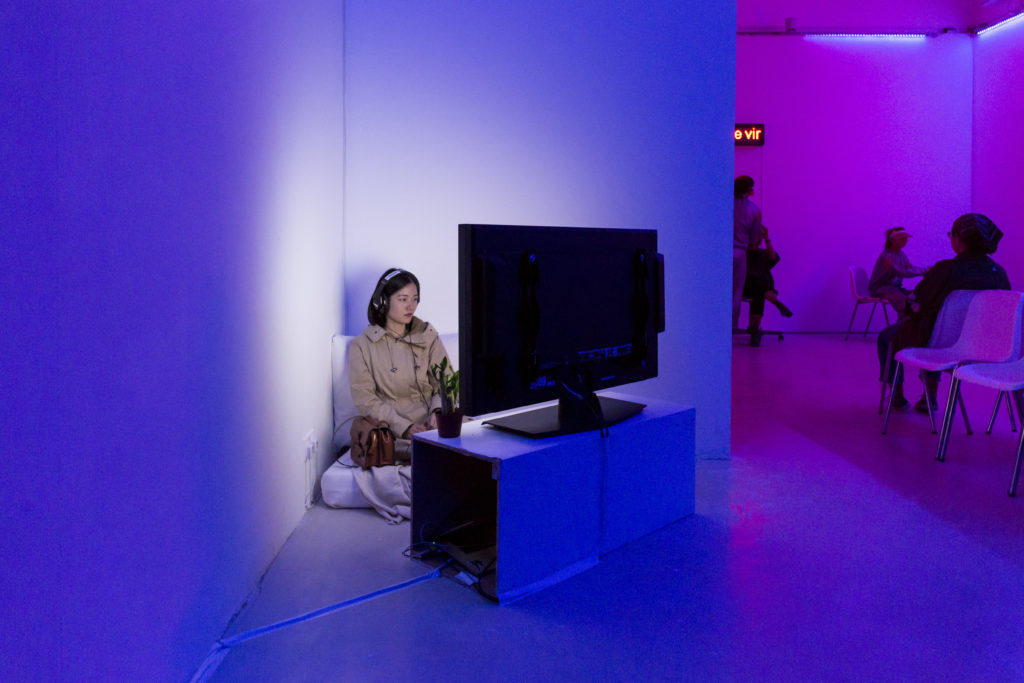
Boredom
The lack of purpose and evidently the feeling of fatigue are a contemporary observation in our post-work-society. This therapy will evoke the sense of occupation and stimulate your determination. Please sort and connect the elements by colour. Our therapist will notify you once the session is over. Until then, please remain seated.
Concept:
What to do with all the free time once humankind would not have to work anymore? Another phenomenon we imagined appearing in the future would be the regression of determination, a growing detachment from a work habitus and lack of concentration. By giving our patients the simplistic, childish-like task of sorting LEGO bricks we wanted them to feel a sensation of purpose and evoke a sense of meaningful work. By doing so through LEGO bricks (which almost everyone has a sort of relation to) we wanted to create a sense of affection and thereby treating the symptoms of detachment.
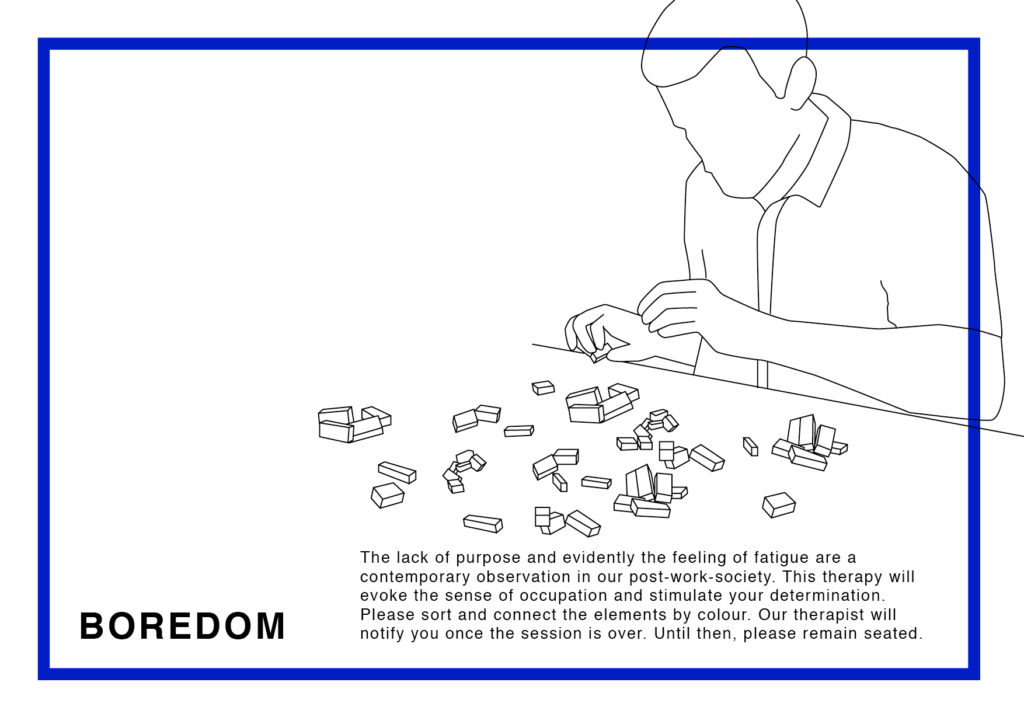
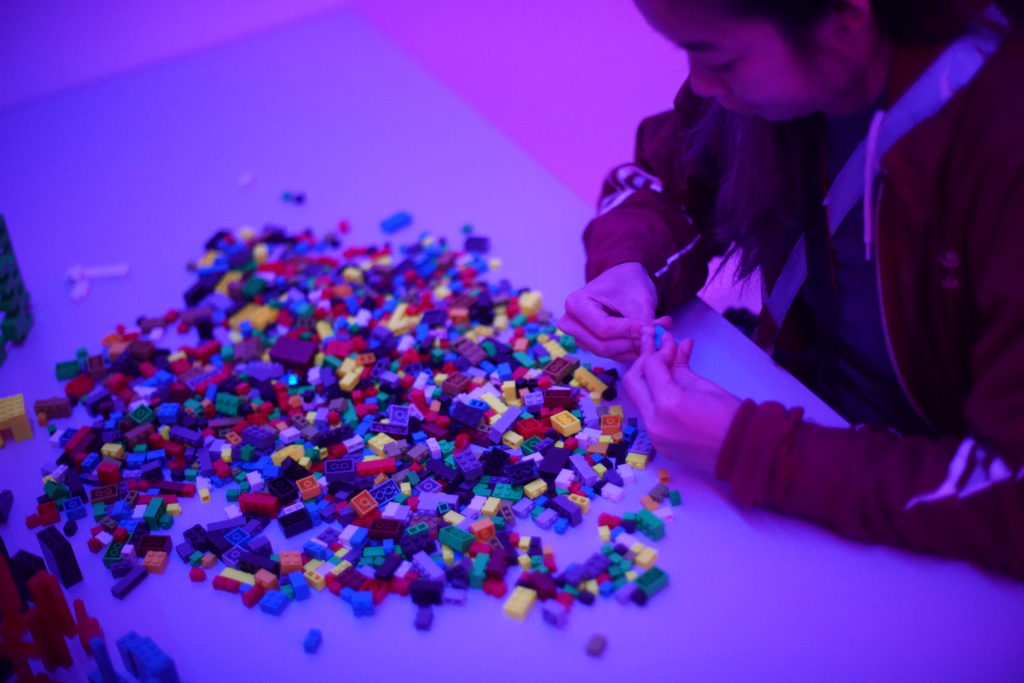
Lethargy
According to our diagnose you are showing signs of lethargy. Our therapist will have a brief session with you, with the intent to raise your spirits and evoke excitement and animation. Because mental health is just as important as physical health.
Concept:
Going to work and receiving a salary is one way of reward for an employee. The other one, debatably more relevant, is the esteem one experiences when an individual defines his personality through a profession. But what would happen with our self-esteem in a future where we could not define ourselves through our jobs? This station was designed for patients who felt a sense of apathy and a lack of gratification without having to work. We put together a set of motivational sentences, which our performer would read out in a very emphatic way. Although our performer would act very sensitive and understanding, the quotes he read out where very generic and the same for every patient. At the end, they would receive a small sticker on their forehead, just like chinese children in Kindergarten after a task they would successfully solve.
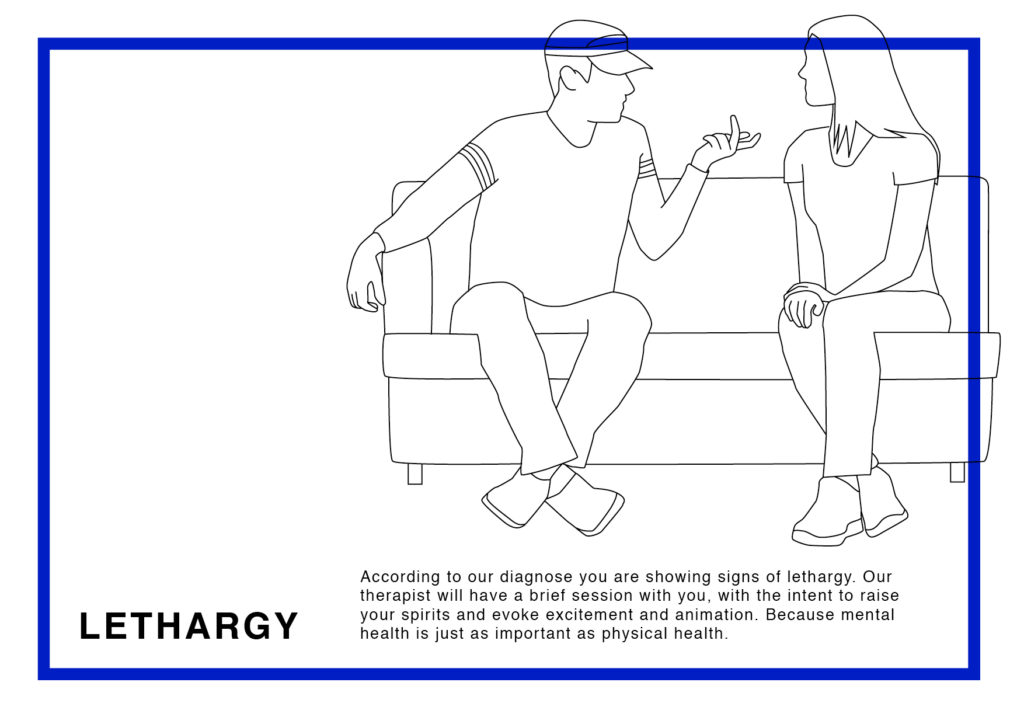
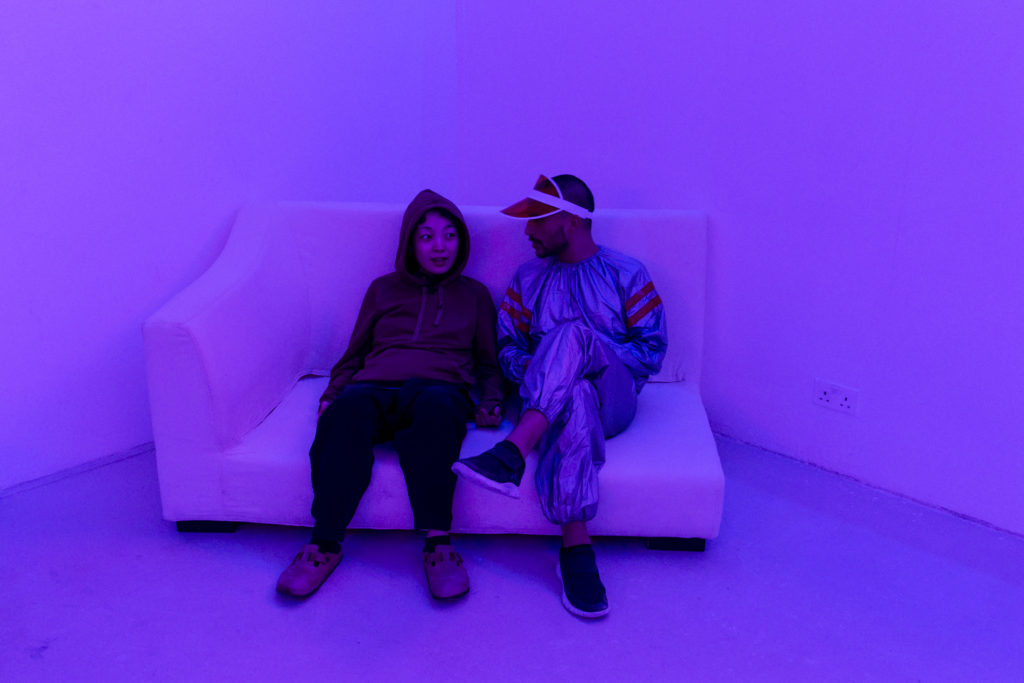
Insignificance
The feeling of insignificance caused by lack of self-realization through work can be anxious. Our lifestyle guide will advise you on various matters, by which you will hopefully quickly gain recognition and increase your prestige.
Concept:
Status and recognition nowadays is often defined through our profession and the appearance it projects to our peers. This station was designed for individuals who were lacking a source of meaningfulness in a life without work. Our performer was equipped with various made-up statistics of trends and tendencies throughout different activities in our everyday lives. He would talk with the patient and evaluate which activities and trends he should perceive in order to gain status and evidently, self-recognition. The statistics could variate from physical activities which where currently taking off to which beverage one should drink when in a bar or a public place.
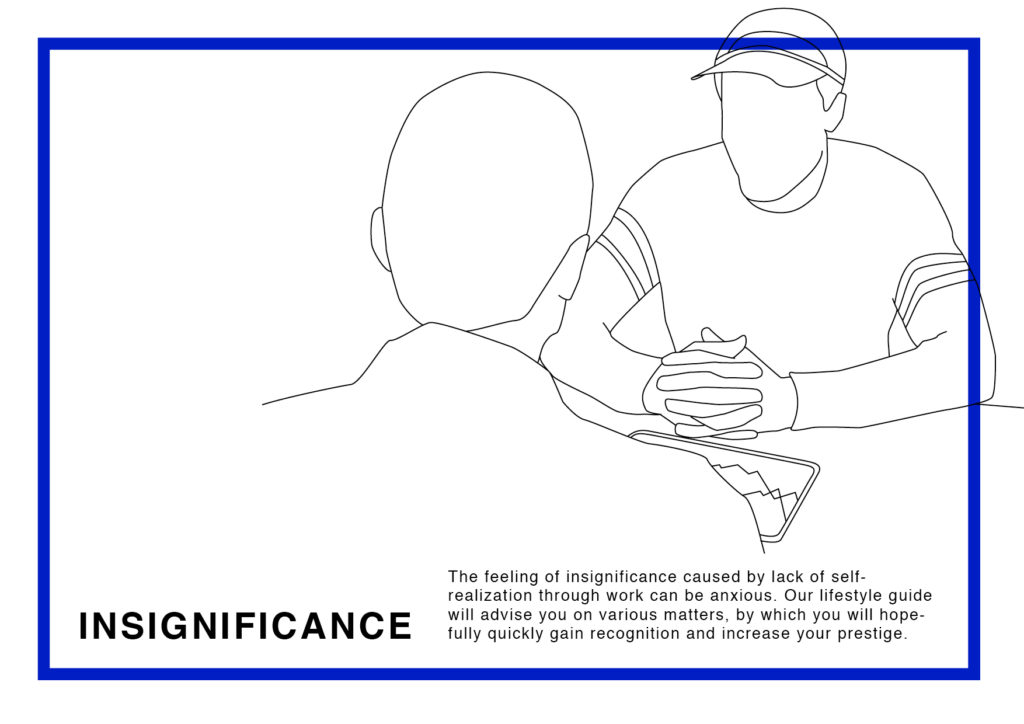
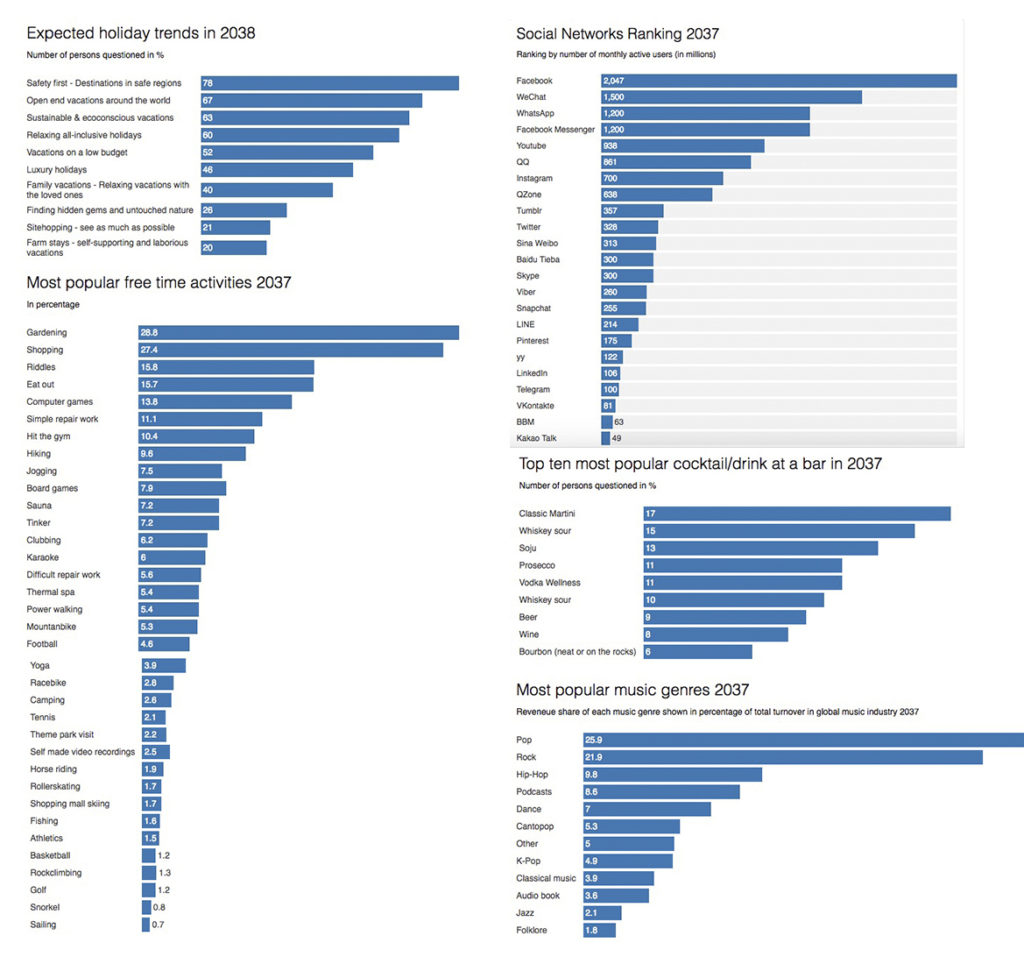
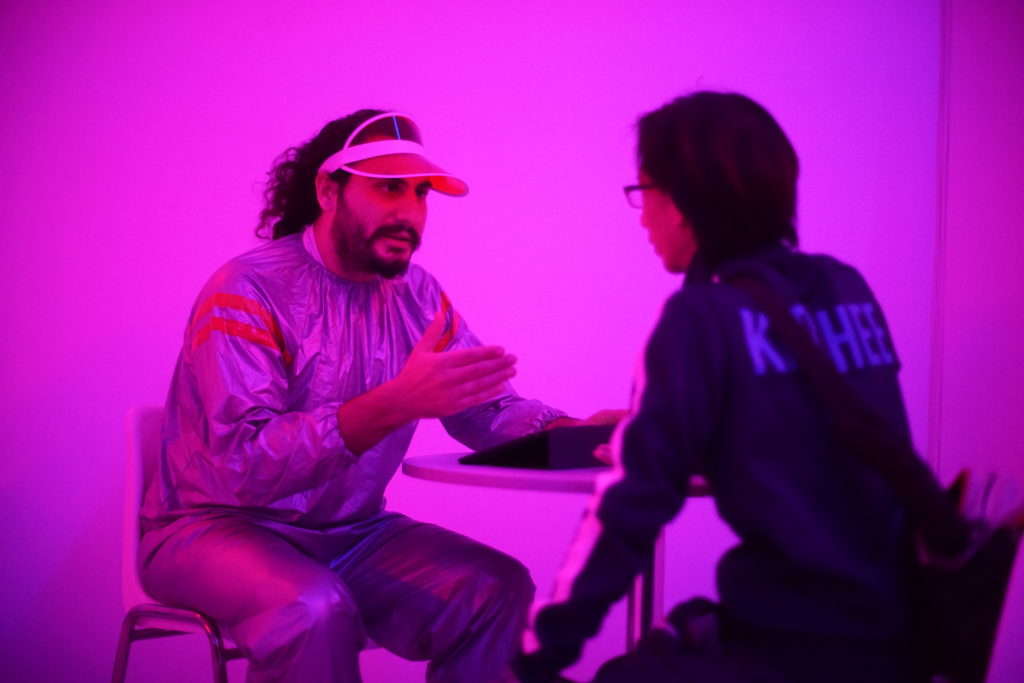
Finish
The session was either over when a therapist advised the patient or, when a patient raised his hand when feeling uncomfortable carrying out the task he or she was ordered to. The patients where then accompanied to another waiting area, which served two purposes: Firstly, to not irritate the individual being diagnosed in at the reception as the entrance to the center was also the exit. Furthermore it was another opportunity for the audience to observe the other stations and the uncanny environment we had created in our space. Coordinated with the diagnosis at the reception, the patient was then accompanied to the exit and had thus finished his therapy.
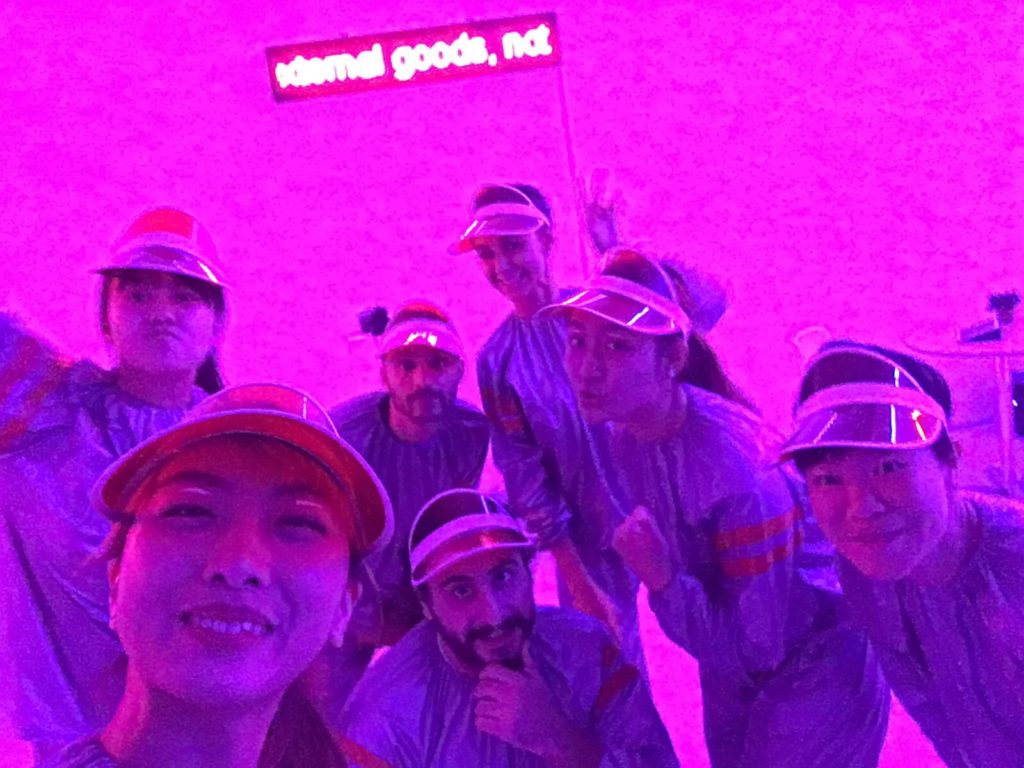
Retrospective and outlook
Looking at the project now, we are content with the way it turned out. Due to the first few research-based weeks the project definitely had a strong background knowledge and a solid foundation. We managed to use the space and – from the feedback we received – get our ideas across.
Since we had various different stations we found ourselves under some time pressure during the last few days. It would have been nice to spend more time thinking about the role of the performers and have one more run-through with them. In a next iteration of the project we would also have to rethink the entrance, since people had to wait for a long time. We still think that receiving the diagnosis one person at the time is important. But the input with the distance sensor was not as clear as we thought and some people had difficulties understanding the computer generated voice. With providing subtitles in English and Cantonese we could have solved this problem.
Over all we thoroughly enjoyed diving into this subject and two of us will continue with projects based on this work. We are thankful to have had this opportunity to do so. The aim of our project was to catch a glimpse of the possibilities that arise with new technologies. Talking about the future is always a very ambivalent undertaking, since many factors come into play. We still pressure the importance of doing so despite the uncertainty. We are convinced that automation will increasingly play a bigger part in our lives and embracing the challenges and opportunities now is the only way to gain a deeper understanding of the matter and coexist rather than struggle with evolving technology. Ultimately, and also an essential drive for approaching this subject, we are in a very privileged and unique position by living in this rapidly changing era, being able to ponder about topics which will profoundly change cohabitation and existing (economical, institutional and social) structures as we know them.
